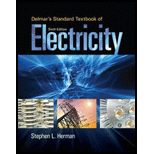
Referring to the circuit described in Questions 8 and 9, determine the drop across each of the resistors.
Want to see the full answer?
Check out a sample textbook solution
Chapter 6 Solutions
Delmar's Standard Textbook of Electricity (MindTap Course List)
- Q4) (i) Calculate the fourier transform of : h(t) 2T (is) h(t) 2T -T о T 2T ·(-++T). cos2t ost≤T (iii) hro (4) ((-++T). cos otherwisearrow_forwardQ2)a) consider the Circuit in figure 2 with initial conditions of Vc (o) = 5V, I₁ (o) = 1A, (i) redraw the circuit in the frequency domain using laplace Wansforms. (ii) using this circuit derive an equation for the Voltage across the inductor in the time domain.. 3.12 ww =V/3F ZH (figure 2) d) Solve the following second order differential equation using laplace transforms. d12 + 5 dx 3x=71 dt - with initial conditions x² (0) = 2, α(0) = 1arrow_forwardb) Another periodic waveform is defined by T c) g(t)= T with g(t+mT) = g(t) and m is an integer. (i) Sketch g(t) over two full cycles in the time domain, labelling the axes. (ii) Derive the formulae for the complex Fourier coefficients c₁ for g(t). For a periodic waveform h(t), if its complex Fourier coefficients are T T when n is odd T 2n²² T 4nn when n is even and not zero 4nn please derive the first five non-zero terms of the real Fourier series for h(t).arrow_forward
- Q3)α) f(t) = (-+- 1 Isto f(t+mT) = f(t). L+- I Ost ST integer (i) sketch f(t) 2 full cycles time domain. (labelling the axis). (ii) Derive the formula for the real fourier Coefficients (i) Real Fourier series f(t), first 5 non-terms. an bn for f(t).arrow_forwardQ3. a) A periodic waveform is defined by T 3 0≤t< f(t) = SIarrow_forwardQ2. a) Sketch the following waveform f(t)=Vo -1/2≤t≤1/2 =0 otherwise and show that its Fourier transform is 2V ωτ ωτ F(s)-sinotsinc) 2 Use this result to sketch a fully labelled graph of the amplitude spectrum of a single square voltage pulse, of amplitude 24V and pulse width 1.4μs, using units of Hz for the frequency axis. (Note: graph paper is not required - a clear, fully-labelled sketch is adequate).arrow_forwardc) Another periodic waveform is defined by 4t g(t)= 0≤tarrow_forwardQ1. a) A periodic waveform is defined by f(t)= 3 0≤tarrow_forwardI have 50mV in the function generator with 10kHz. Does the connection and reading seem about right? I need to read output voltage.arrow_forwardThe solution sent previously is incorrect; I need the correct solution. An antenna with a radiation impedance of 75+j10 ohm, with 10 ohm loss resistance, is connected to a generator with open-circuit voltage of 12 v and an internal impedance of 20 ohms via a 2/4-long transmission line with characteristic impedance of 75 ohms. (a) Draw the equivalent circuit (c) Determine the power radiated by the antenna.arrow_forwardFIU Quiz: Take Quiz 1: Chapter 1 courses/217034/quizzes/1318866/take S M Inbox (40,079) - josesanchez11: X + 2. For the circuit in figure below: (a) Identify and label all distinct nodes. (b) Which of those nodes are extraordinary nodes? (c) Identify all combinations of 2 or more circuit elements that are connected in series. (d) Identify pairs of circuit elements that are connected in parallel. ww 25 Ω 12 V +1 40 Ω 10 Ω 60 Ω ww 2502 Ω 30 Ω 20 Ω 15 Ω ww Upload Choose a File X legearrow_forwardSolve the octic polynomial 2s⁸+s⁷+2s⁶-31s⁴-16s³-32s²-160=0 Only expert should attempt this question,no artificial intelligencearrow_forwardarrow_back_iosSEE MORE QUESTIONSarrow_forward_iosRecommended textbooks for you
 Delmar's Standard Textbook Of ElectricityElectrical EngineeringISBN:9781337900348Author:Stephen L. HermanPublisher:Cengage Learning
Delmar's Standard Textbook Of ElectricityElectrical EngineeringISBN:9781337900348Author:Stephen L. HermanPublisher:Cengage Learning
 Delmar's Standard Textbook Of ElectricityElectrical EngineeringISBN:9781337900348Author:Stephen L. HermanPublisher:Cengage LearningMesh Current Problems in Circuit Analysis - Electrical Circuits Crash Course - Beginners Electronics; Author: Math and Science;https://www.youtube.com/watch?v=DYg8B-ElK0s;License: Standard Youtube License
Delmar's Standard Textbook Of ElectricityElectrical EngineeringISBN:9781337900348Author:Stephen L. HermanPublisher:Cengage LearningMesh Current Problems in Circuit Analysis - Electrical Circuits Crash Course - Beginners Electronics; Author: Math and Science;https://www.youtube.com/watch?v=DYg8B-ElK0s;License: Standard Youtube License